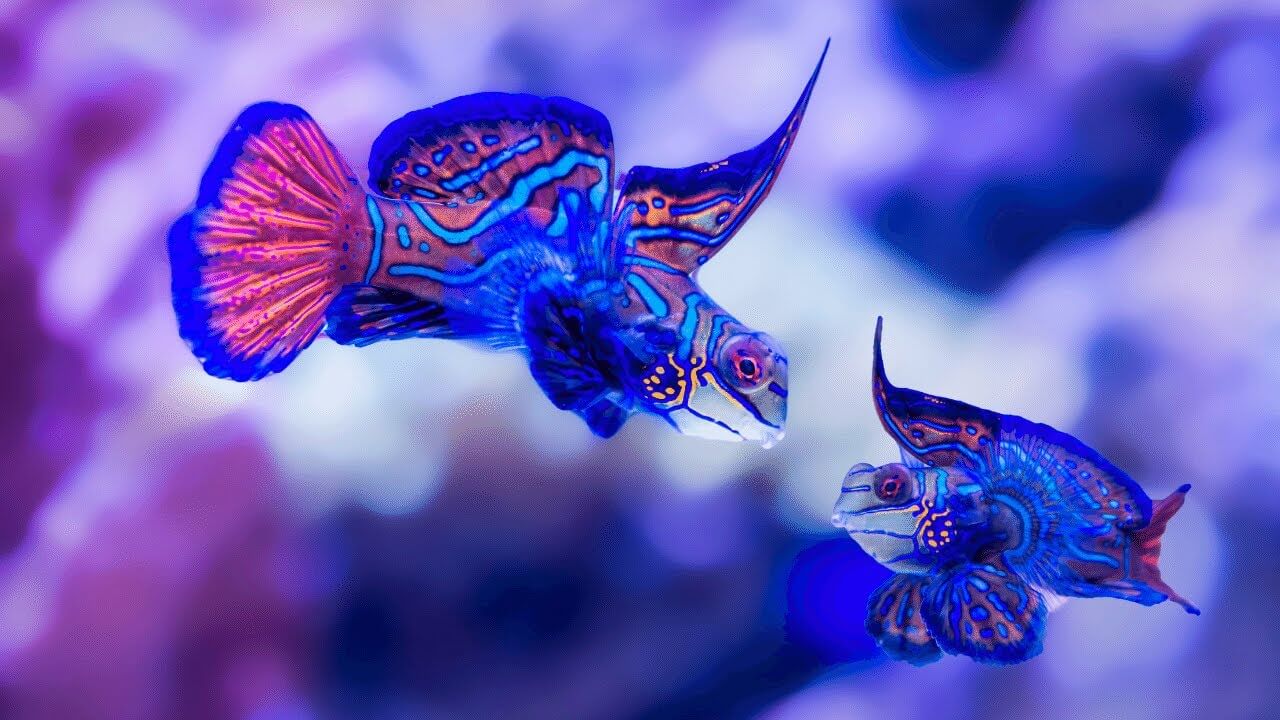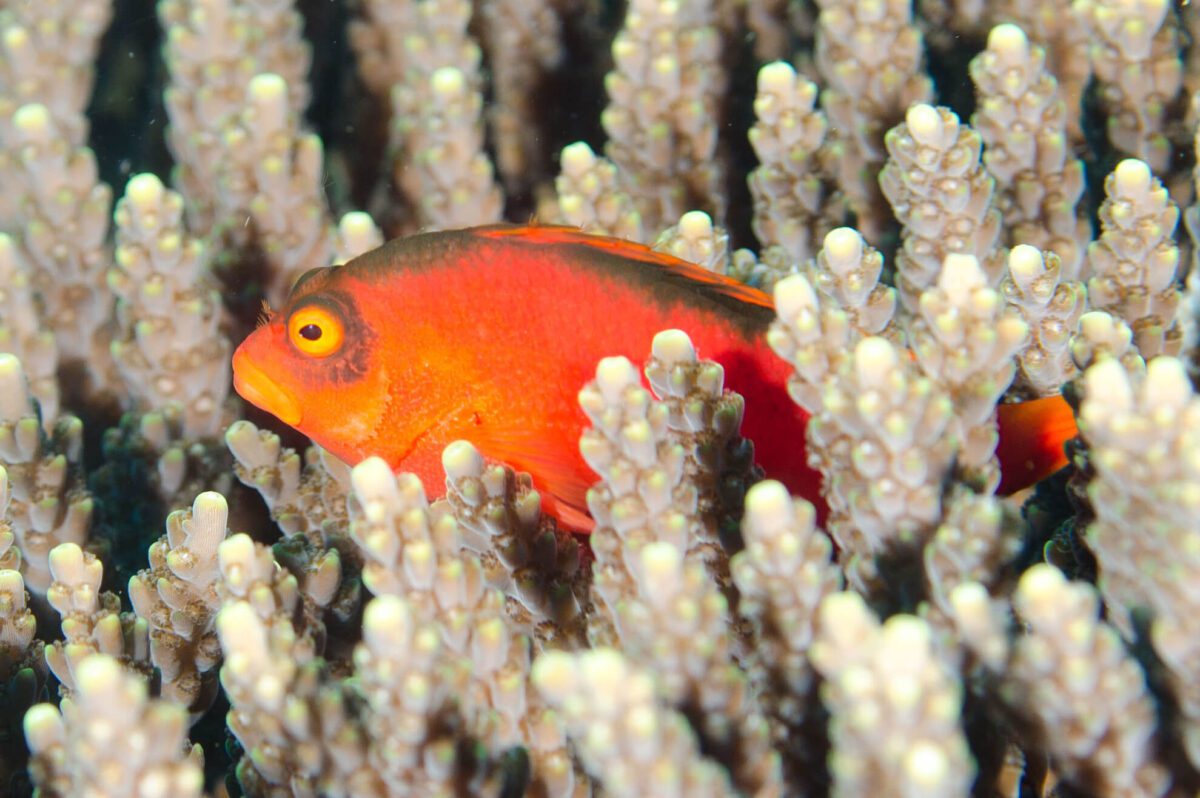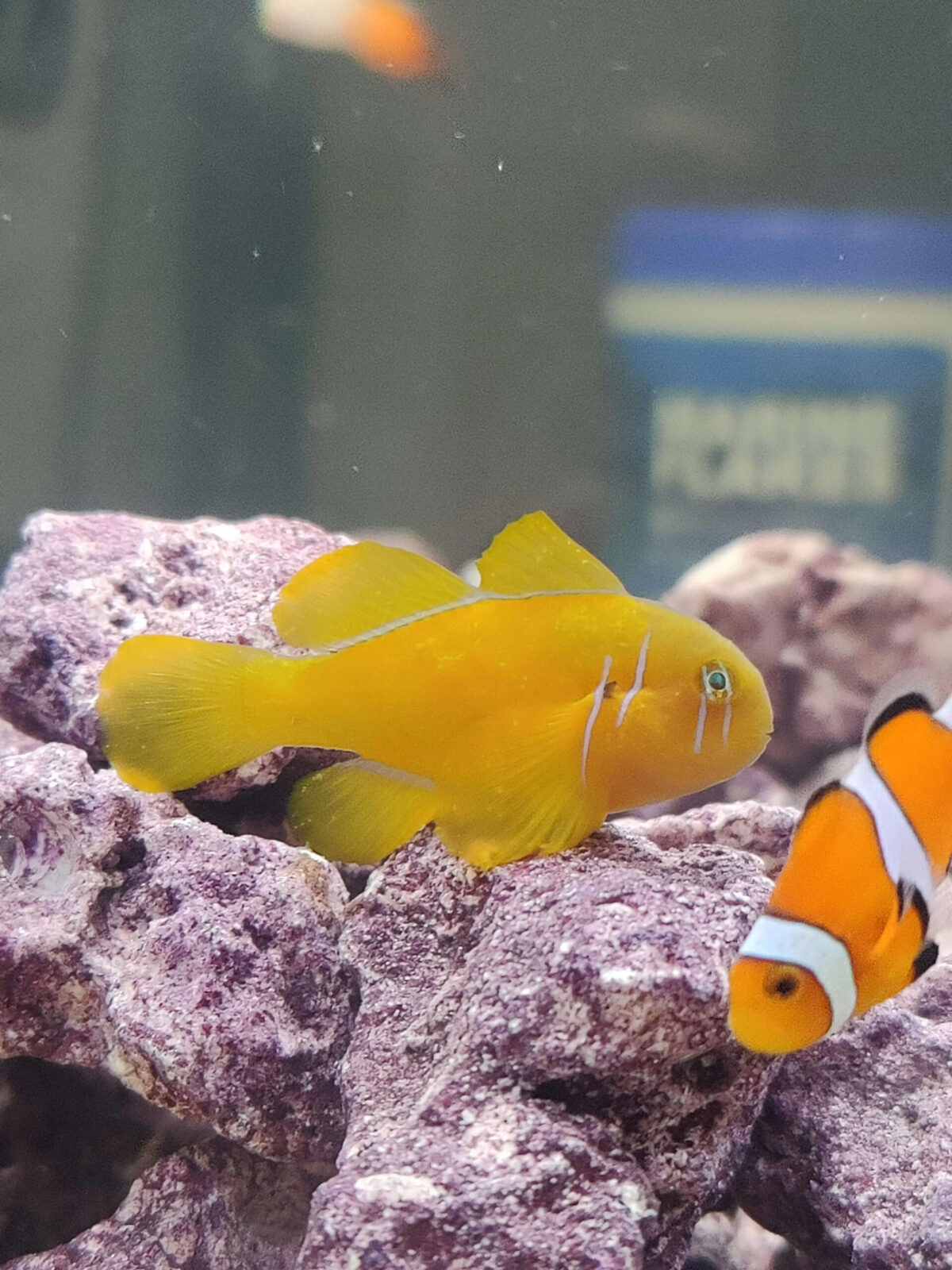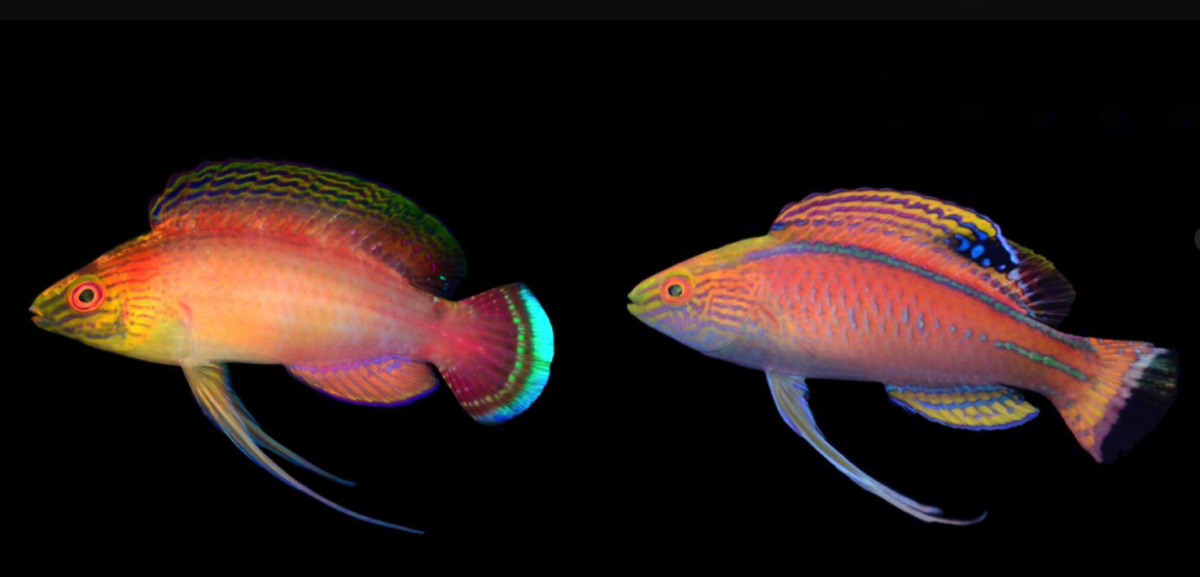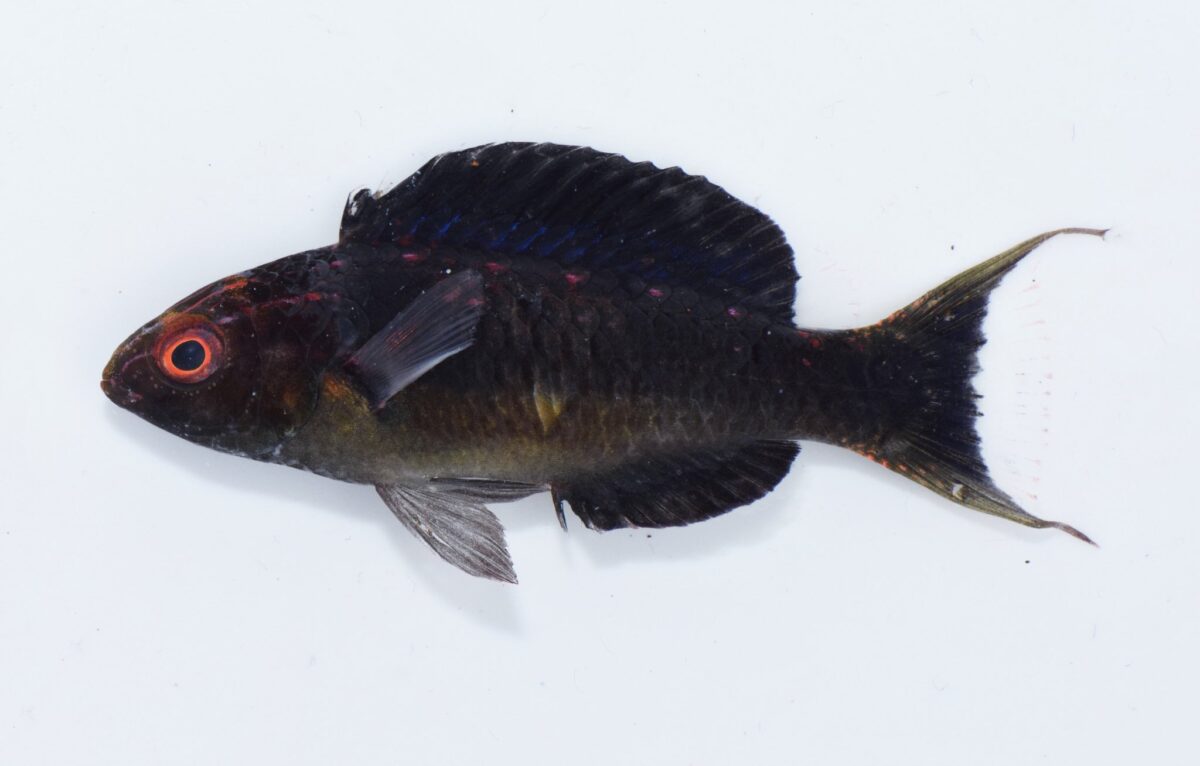This species guide will explore the captivating world of the Mandarin Dragonet, also known as Synchiropus splendidus. From its vibrant colors to its unique appearance, this saltwater aquarium fish is a favorite among aquarists and a stunning addition to any aquascaping design. Whether you’re a seasoned reef tank enthusiast or a beginner looking for colourful companions, the Mandarin Dragonet is sure to impress.
Key Takeaways:
- The Mandarin Dragonet, or Synchiropus splendidus, is a mesmerizing saltwater aquarium fish.
- Its vibrant colors and unique appearance make it a popular choice for aquascaping designs.
- When selecting tank mates, ensure compatibility with the Mandarin Dragonet’s peaceful temperament.
- Providing the ideal tank size, water parameters, and a nutritious diet are essential for its well-being.
- Consider captive-bred Mandarin Dragonets for sustainable fishkeeping and conservation efforts.
Introduction to the colourful Mandarin Dragonet (Synchiropus splendidus)
Welcome to the world of the Mandarin Dragonet, a vibrant saltwater species that has captured the hearts of marine aquarium enthusiasts. In this section, we will introduce the Mandarin Dragonet by exploring its taxonomy and classification and delving into its natural habitat and distribution.
Taxonomy and Classification
The Mandarin Dragonet, scientifically known as Synchiropus splendidus, belongs to the family Callionymidae. It is a small, colourful fish highly prized for its striking appearance and intricate patterns. As part of the Callionymidae family, the Mandarin Dragonet is closely related to other stunning species like the Scooter Dragonet (Synchiropus ocellatus) and the Spotted Dragonet (Synchiropus picturatus).
| Attribute | Description |
|---|---|
| Scientific Name: | Synchiropus splendidus |
| Common Names: | Mandarin Dragonet, Mandarin Goby, Psychedelic Mandarinfish |
| Origin: | Western Pacific |
| Family: | Callionymidae |
| Social: | Peaceful |
| Domain in Tank: | Bottom Dweller |
| Minimum Tank Size: | 30 gallons (113.5 liters) |
| Diet: | Carnivore; prefers live foods such as copepods and amphipods |
| Breeding: | Difficult in captivity |
| Care Level: | Moderate to Difficult |
| pH Range: | 8.1 – 8.4 |
| Water Hardness: | 8-12 dKH |
| Temperature: | 72-82°F (22-28°C) |
| Common Diseases: | None specific, but vulnerable to stress-related diseases due to improper diet or tank conditions |
| Life Span: | Up to 5 years |
| Size: | Up to 4 inches (10 cm) |
| Best Tank Mates: | Peaceful reef fish, avoids aggressive species |
Natural Habitat and Distribution
The Synchiropus splendidus is native to the Pacific Ocean and can be found in the coastal waters of the Indo-Pacific region, specifically in areas like the Philippines, Fiji, Indonesia, and Australia’s Great Barrier Reef. These fish inhabit coral reefs, seeking refuge and food amidst the vibrant corals and rocky crevices.
Mandarin Dragonet Physical Description and Characteristics
In this section, we will delve into the physical description and characteristics of the Mandarin Dragonet. Known scientifically as Synchiropus splendidus, these captivating saltwater fish are renowned for their vibrant colours and unique physical features.
Colours and Markings
The Mandarin Dragonet is a true gem in the aquarium world, displaying stunning hues that resemble an artist’s palette. Its body is adorned with a mesmerizing combination of blues, greens, oranges, and vibrant patterns, making it a standout species for any aquarist.
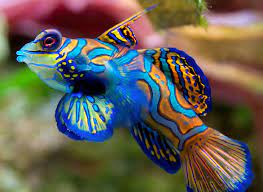
Gender Differences
Regarding gender differences, male Mandarin Dragonets can be easily distinguished by their more elongated and pointed dorsal fin than females. Additionally, males have more vibrant and intricate patterns, showcasing their beauty during courtship displays.
Varieties
While there is a remarkable diversity of colours and patterns within the Mandarin Dragonet species, no distinct varieties or subspecies exist. However, each specimen possesses its unique combination of colours and markings, making every Mandarin Dragonet a truly one-of-a-kind addition to your aquarium.
Grades
In the aquarium trade, Mandarin Dragonets are often graded based on the quality and intensity of their colours and their overall health and condition. Higher-grade specimens exhibit more vibrant colouration and have a better chance of thriving in a well-maintained aquarium environment.
Behavior and Temperament
Mandarin Dragonets are peaceful and generally non-aggressive towards other tank inhabitants. They have a calm and leisurely swimming style, gracefully gliding through the water column. These fish may spend their time exploring rockwork and perching on coral branches, adding a touch of elegance to any aquascape.
Aquarium Requirements
To provide the best care for your Mandarin Dragonet, it is important to understand their specific aquarium requirements. By creating the ideal environment, you can ensure their health, well-being, and vibrant colours. Let’s explore the key aspects to consider:
Perfect Tank Size and Layout
Regarding the tank size for Mandarin Dragonets, bigger is always better. Aim for a minimum tank size of 30 gallons (113 litres) to provide ample swimming space. Additionally, the tank should have a well-designed aquascaping layout to accommodate their natural behaviour.
This can include adding live rock structures, caves, and crevices for the Mandarin Dragonet to explore and seek shelter. By providing suitable hiding spots, you create a visually appealing aquarium and help reduce stress for your fish.
Water Parameters
Maintaining stable water parameters is crucial for the health of your Mandarin Dragonet. They thrive in a saltwater aquarium with temperatures ranging from 72-78°F (22-25.5°C) and a pH of 8.1-8.4. It is essential to regularly test and monitor the water quality to ensure optimal conditions.
Proper filtration is essential, as Mandarin Dragonets are sensitive to high levels of nitrates and fluctuations in water chemistry. Consider using a protein skimmer and a powerhead to maintain water flow and oxygenation, creating an ideal environment for your fish.
Suitable Tank Mates and Potential Conflicts
When selecting tank mates for your Mandarin Dragonet, choosing peaceful and non-aggressive species that can coexist harmoniously is important. Avoid keeping them with larger, territorial fish that may intimidate or harm them.
Good tank mates for the Mandarin Dragonet include peaceful reef-safe species such as gobies, blennies, and small wrasses. However, exercise caution when introducing other fish with similar body shapes and coloration, as they may trigger aggression or territorial behavior.
Compatibility with Live Plants and Invertebrates
Mandarin Dragonets are generally compatible with live plants and invertebrates in a well-established saltwater aquarium. However, remember that they may occasionally nibble on small crustaceans and copepods that are part of their natural diet.
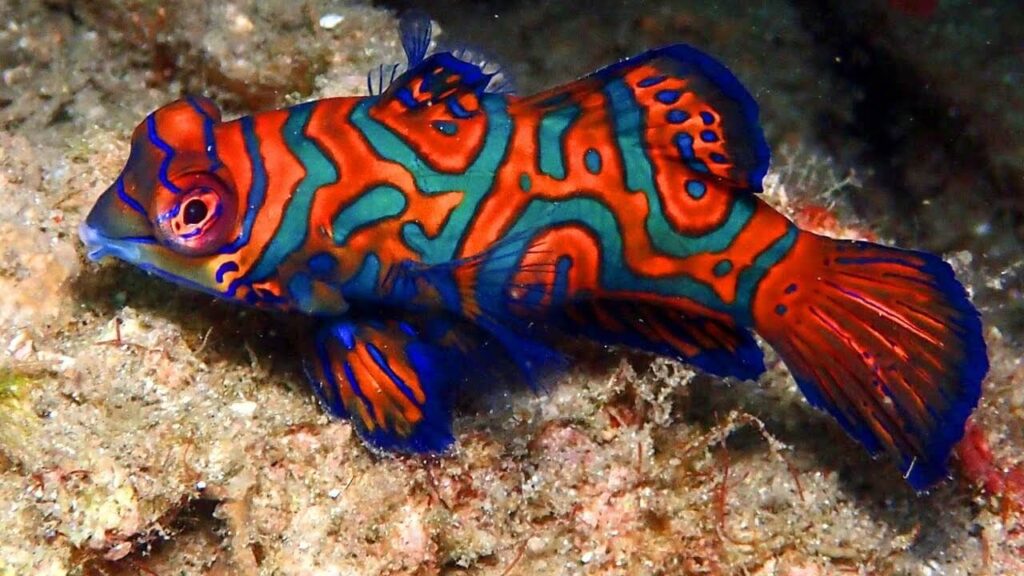
If you incorporate live plants, select species that can tolerate saltwater conditions, such as marine macroalgae. Additionally, ensure that any invertebrates you add, such as shrimp or snails, are not aggressive and do not threaten your Mandarin Dragonet.
Following these aquarium requirements can provide a suitable and thriving environment for your Mandarin Dragonet. Remember to monitor the water parameters regularly and choose compatible tank mates to ensure the well-being of your beautiful fish.
Mandarin Dragonet – Care
In this section, we will focus on the care of Mandarin Dragonets. These beautiful saltwater fish require specific care to thrive in a home aquarium. By following these care guidelines, you can ensure the health and well-being of your Mandarin Dragonet.
Diseases
Mandarin Dragonets are generally hardy fish when provided with the proper care and environment. However, they can still be susceptible to certain diseases. It is essential to be aware of common ailments and take preventive measures to keep your Mandarin Dragonet healthy.
One common disease that affects Mandarin Dragonets is ich, also known as white spot disease. This is caused by a parasite that presents as white spots on the fish’s body. To prevent ich, maintain optimal water quality and avoid introducing new fish without quarantine.
1. Marine Ich (Cryptocaryon irritans)
- Symptoms: White spots on skin, gills, and fins, resembling grains of salt; fish may scratch against objects due to irritation.
- Prevention: Maintain optimal water quality, quarantine new arrivals, and manage stress levels in the tank.
- Treatment: Quarantine infected fish and treat them with copper-based medications or hypersalinity therapy, as recommended for marine setups.
2. Marine Velvet (Amyloodinium ocellatum)
- Symptoms: Fine, dust-like yellow or gold spots on the body, rapid breathing, cloudiness of eyes, and lethargy.
- Prevention: Similar to Marine Ich, emphasising quarantine and water quality.
- Treatment: Copper-based treatments or chloroquine phosphate in a quarantine tank.
3. Bacterial Infections
- Symptoms: Ulcers, sores, fin rot, abnormal swimming, lethargy.
- Prevention: Clean the tank, avoid overcrowding, and ensure proper nutrition.
- Treatment: Antibiotics, either in the food or water, depending on the infection’s nature and severity.
4. Nutritional Deficiencies
- Symptoms: Loss of colour, lethargy, weight loss.
- Prevention: Provide a varied diet rich in appropriate nutrients, focusing on live foods like copepods to mimic their natural diet.
- Treatment: Improving the diet by including live foods and possibly supplementing with vitamins and minerals.
5. Parasitic Infections (Other than Ich and Velvet)
- Symptoms: May include visible parasites on the body, erratic swimming, scratching, weight loss.
- Prevention: Quarantine new fish and live foods, maintain clean water.
- Treatment: Treatment depends on the type of parasite; consult a veterinarian for diagnosis and treatment options, including antiparasitic medications.
General Prevention and Treatment Strategies:
- Quarantine: New arrivals should be quarantined for at least 2-4 weeks to prevent the introduction of diseases.
- Water Quality: Regular water testing and maintenance to keep parameters (pH, temperature, salinity, nitrates, and ammonia) within optimal ranges.
- Diet: A balanced diet is crucial for immune system health.
- Observation: Regularly observe your fish for any signs of disease or distress.
Another health concern for Mandarin Dragonets is shrimp aggression syndrome. These fish are instinctive to hunt and feed on small crustaceans like copepods and amphipods. In captivity, they may mistake cleaner shrimp or other ornamental shrimp as prey, leading to aggression. It is advisable to carefully select tank mates and provide ample hiding places to prevent conflicts.
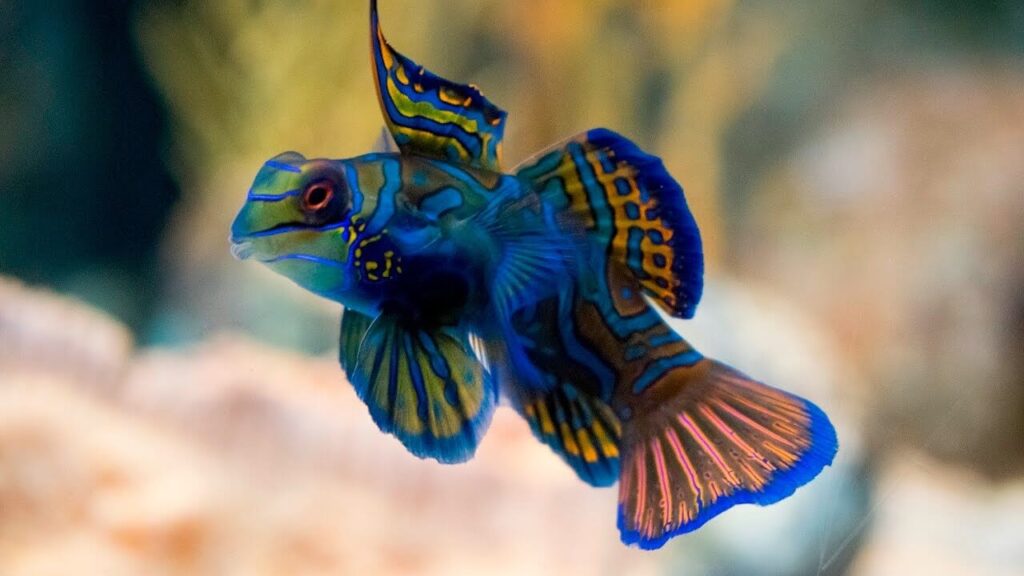
To minimize the risk of diseases, it is essential to maintain good water quality and cleanliness in your aquarium. Regular water changes, proper filtration, and monitoring of critical parameters such as temperature, salinity, and pH are crucial for the well-being of Mandarin Dragonets.
Suppose you notice any signs of illness in your Mandarin Dragonet, such as changes in behaviour, loss of appetite, or visible abnormalities. In that case, consulting with a qualified aquatic veterinarian or seeking advice from experienced aquarium hobbyists is recommended.
By providing a stress-free environment, a balanced diet, and regular observation, you can ensure the long-term health and happiness of your Mandarin Dragonet.
Diet and Feeding
To maintain the health and vitality of your Mandarin Dragonet, it is crucial to provide them with a proper diet that meets their nutritional needs. These colourful and captivating saltwater fish have specific dietary preferences and feeding requirements that should be considered for their overall well-being.
Dietary Preferences
Mandarin Dragonets are primarily carnivorous, and their natural diet consists of small invertebrates and crustaceans found in the wild. They have a voracious appetite for copepods, amphipods, and other tiny organisms that dwell in live rock and sand. Therefore, it is essential to replicate their natural feeding behaviour in the aquarium to ensure their long-term health and happiness.
Live Foods
Mandarin Dragonets primarily feed on small, live crustaceans in their natural habitat. Providing a diet that closely mimics their natural feeding habits is crucial for their survival in aquariums.
- Copepods: These are small crustaceans that are an essential part of the Mandarin Dragonet’s diet. A healthy, thriving copepod population in the aquarium is crucial for keeping Mandarin Dragonets fed.
- Amphipods: Similar to copepods, these are slightly larger crustaceans that Mandarin Dragonets will also eat.
- Mysis shrimp: While not as small as copepods or amphipods, live mysis shrimp can be a good dietary addition, especially for larger or more acclimated Mandarin Dragonets.
Prepared Foods
While live foods should comprise the bulk of their diet, some Mandarin Dragonets can be trained to eat frozen or prepared foods. This transition can be challenging and requires patience.
- Frozen mysis shrimp: A possible option for Mandarin Dragonets trained to accept non-live foods.
- Frozen brine shrimp: Another option for trained individuals, though not as nutritionally complete as mysis shrimp.
- Specialized prepared diets: Some manufacturers offer frozen or dried foods formulated specifically for picky eaters like Mandarin Dragonets. These often include a mixture of marine proteins and are enriched with vitamins and minerals.
Recommended Foods and Feeding Schedule
Feeding Mandarin Dragonets can be challenging due to their specific dietary needs. While they may consume prepared foods, offering a variety of live or frozen foods is essential to meet their nutritional requirements fully. Nutrient-rich live foods such as copepods and amphipods should be a staple of their diet.
Additionally, you can supplement their diet with frozen mysis shrimp, small pieces of fish, and other meaty foods. It is crucial to ensure that the food provided is appropriate in size for their tiny mouths, as larger pieces may be difficult for them to consume.
As for the feeding schedule, Mandarin Dragonets should be fed multiple times throughout the day to mimic their natural grazing behaviour. Offering small amounts of food spread out over several feedings helps to promote healthy digestion and prevents overeating.
Feeding Tips
- Frequent Feeding: Mandarin Dragonets must eat frequently due to their constantly foraging nature. In a home aquarium, they should be fed at least twice a day if possible.
- Sustaining Live Food Populations: For those relying on copepods and amphipods, maintaining a refugium or a separate breeding tank for these organisms can help provide a continuous food source.
- Observation: Pay close attention to your Mandarin Dragonet’s behaviour and body condition. If they appear thin or are not actively foraging, you may need to adjust their diet or feeding methods.
Challenges
- Competition: Ensure that other tank inhabitants are not outcompeting the Mandarin Dragonet for food. They are slow, deliberate feeders and can easily be outcompeted by faster, more aggressive fish.
- Nutritional Balance: While live foods are essential, ensuring a varied diet that meets all their dietary needs is also important. Supplements and vitamin-enriched foods can help in this regard.
Tips on Ensuring a Balanced and Nutritious Diet
To ensure a balanced and nutritious diet for your Mandarin Dragonet, consider the following tips:
- Provide a diverse range of live and frozen foods to replicate their natural diet.
- Closely monitor their feeding behaviour to ensure they are consuming enough food.
- Avoid overfeeding, as Mandarin Dragonets have small stomachs and can be prone to obesity if overindulged.
- Regularly supplement their diet with high-quality vitamin and mineral supplements for marine fish.
- Keeping their environment clean and free from excessive waste and uneaten food can negatively impact water quality.
Following these tips and providing a well-rounded diet can help your Mandarin Dragonet thrive and showcase its vibrant colors and natural behaviors in your marine aquarium.
Breeding and Reproduction
Sexing
Mandarin Dragonets, also known as Synchiropus splendidus, are sexually dimorphic, meaning that male and female specimens display noticeable differences. To determine the sex of a Mandarin Dragonet, you can observe its colouration and fin morphology. Males typically possess brighter, more vibrant colours, with elongated dorsal fins and filamentous extensions on their pelvic fins. Females, on the other hand, have a more subdued colouration and shorter fins.
Breeding Behavior and Conditions
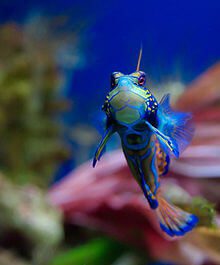
Mandarin Dragonets engage in an elaborate courtship display, with males performing acrobatic dances to attract females. Once a pair has formed, they will retreat to a secluded area within the aquarium to begin breeding.
Providing the Mandarin Dragonets with a well-established reef tank environment is essential to encourage successful breeding. This means ensuring proper water quality, stable parameters, and ample hiding places for Mandarin Dragonets’ shy and secretive breeding behaviour.
Care of Eggs and Fry
After successful breeding, the female Mandarin Dragonet will lay adhesive eggs on the chosen substrate. It is crucial to monitor and protect the eggs from potential harm carefully. Separating the adult Mandarin Dragonets from the eggs is advisable to prevent accidental damage. The eggs will hatch after approximately 8-10 days, revealing tiny fry that require specialized care in their early stages. Providing suitable live foods such as copepods and rotifers will help ensure the proper growth and development of the fry.
Challenges in Breeding in Captivity
Captive breeding of Mandarin Dragonets can be challenging due to their specific dietary requirements, sensitive nature, and complex breeding behaviour. The availability of suitable live foods for the fry, such as copepods, can be a significant obstacle. Additionally, creating the ideal conditions for breeding, such as establishing a stable and matured reef tank environment, can take time and patience. However, advancements in captive breeding techniques offer hope for increasing the availability of Mandarin Dragonets in the aquarium trade and reducing pressure on wild populations.
Summary
Throughout this comprehensive guide, we have explored the fascinating Mandarin Dragonet (Synchiropus splendidus) world. These vibrant saltwater species are known for their stunning colors and have become famous for colorful aquarium displays.
We began by discussing the taxonomy and classification of the Mandarin Dragonet, introducing it as Synchiropus splendidus. We also explored its natural habitat and distribution, shedding light on where it can be found in the wild.
Regarding physical description and characteristics, we delved into the colourful markings and gender differences of the Mandarin Dragonet. We also discussed different varieties and grades and their behaviour and temperament in an aquarium setting.
We further explored the specific aquarium requirements for keeping Mandarin Dragonets, including the ideal tank size and layout, water parameters, suitable tank mates, and compatibility with live plants and invertebrates. We also provided insights into the care and health of Mandarin Dragonets, highlighting common diseases and how to prevent and treat them.
Additionally, we touched upon the dietary preferences, recommended foods, and feeding schedule to ensure a balanced and nutritious diet for these captivating fish. Lastly, we explored the breeding and reproduction of Mandarin Dragonets, discussing sexing, breeding behaviour and conditions, care of eggs and fry, and the challenges of captive breeding.
In conclusion, the Mandarin Dragonet is a vibrant, colourful aquarium fish that captivates hobbyists with its beauty. By understanding their specific care requirements and providing a suitable environment, enthusiasts can enjoy the elegance and allure of these stunning saltwater species in their aquatic displays.

